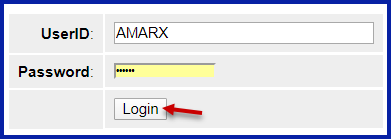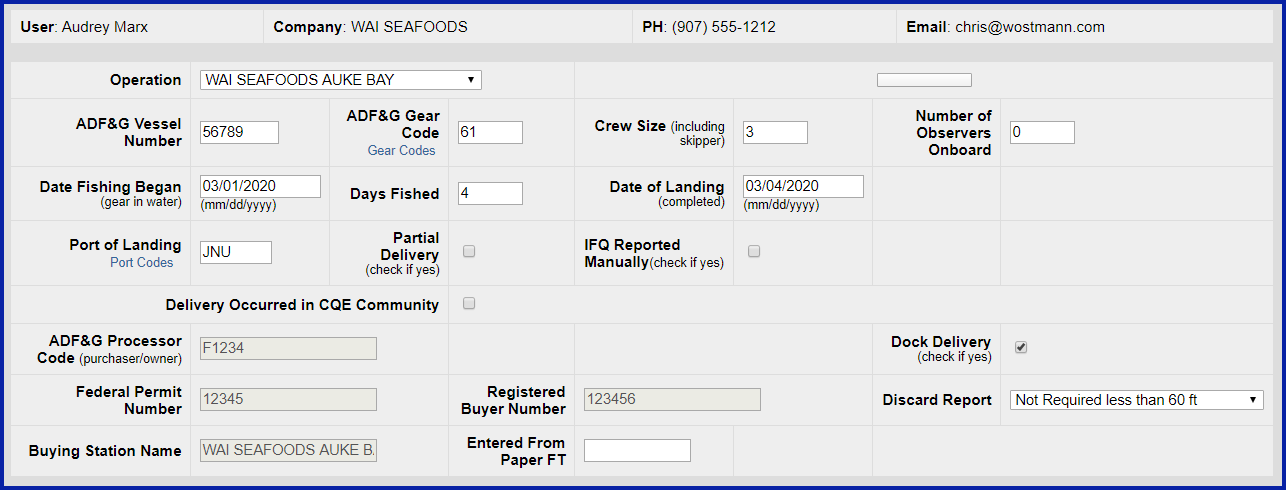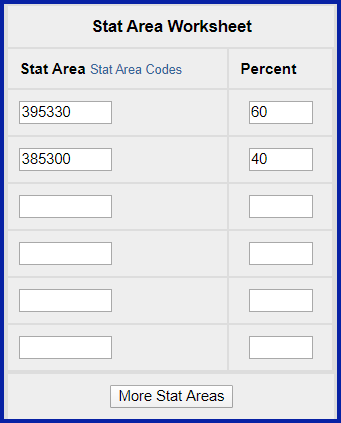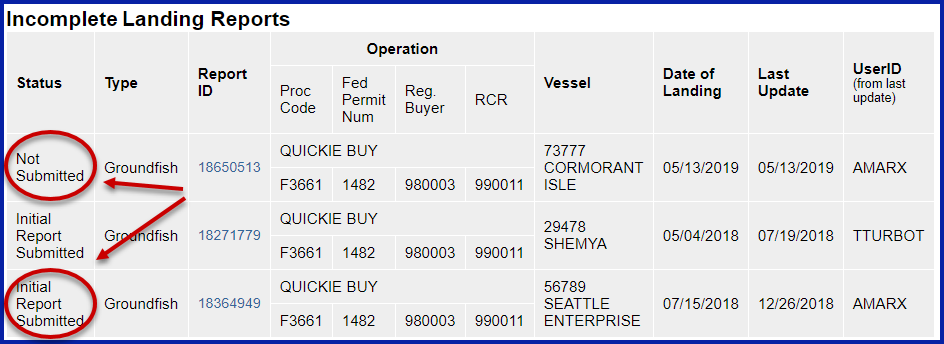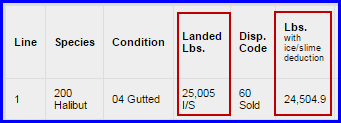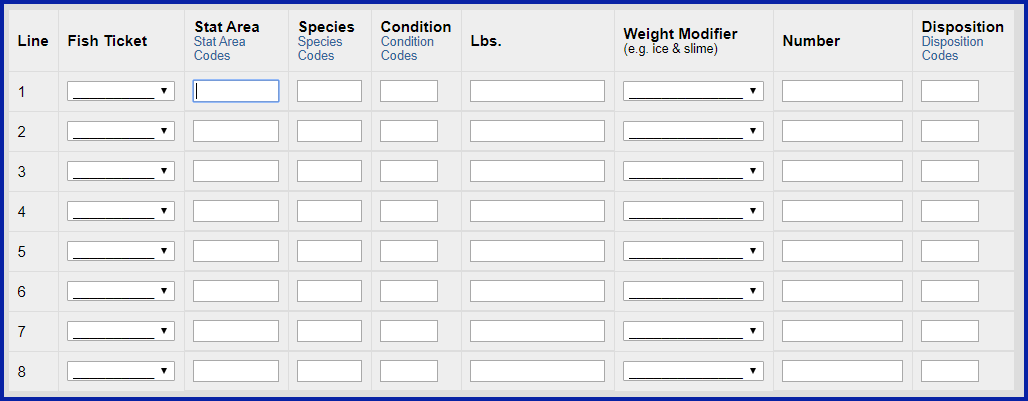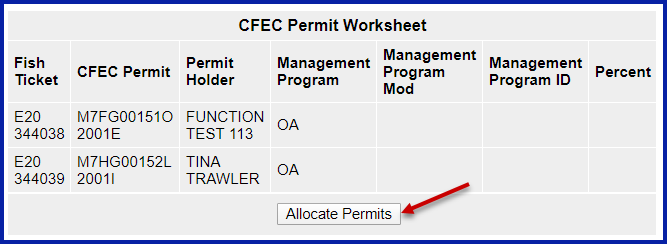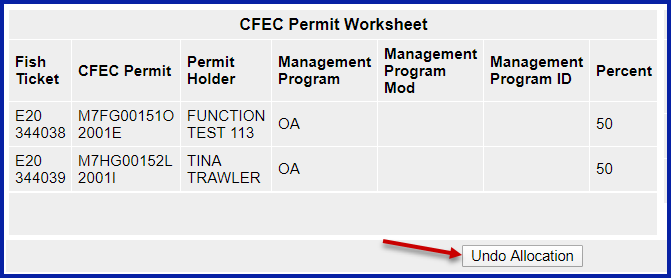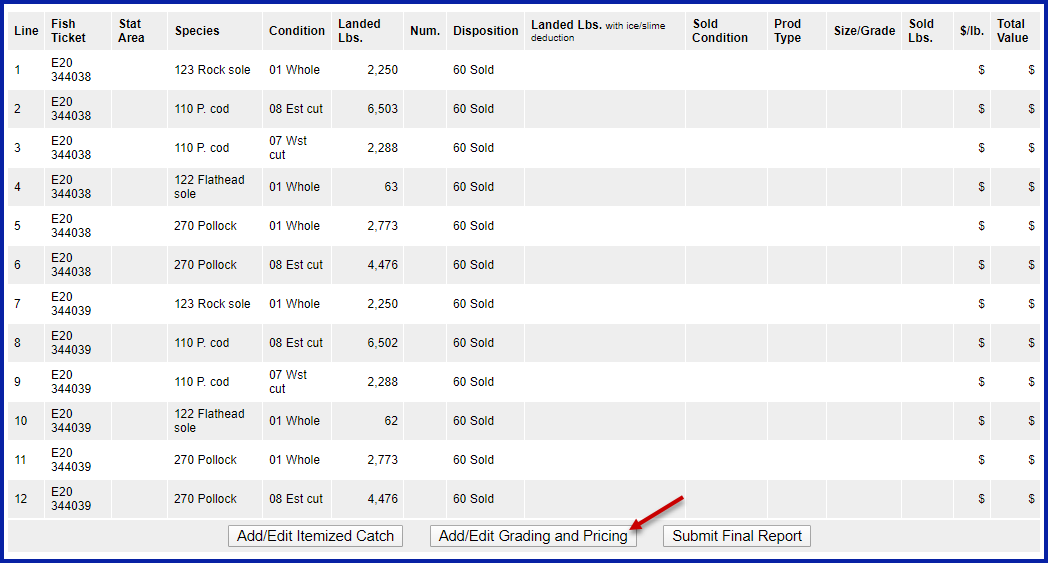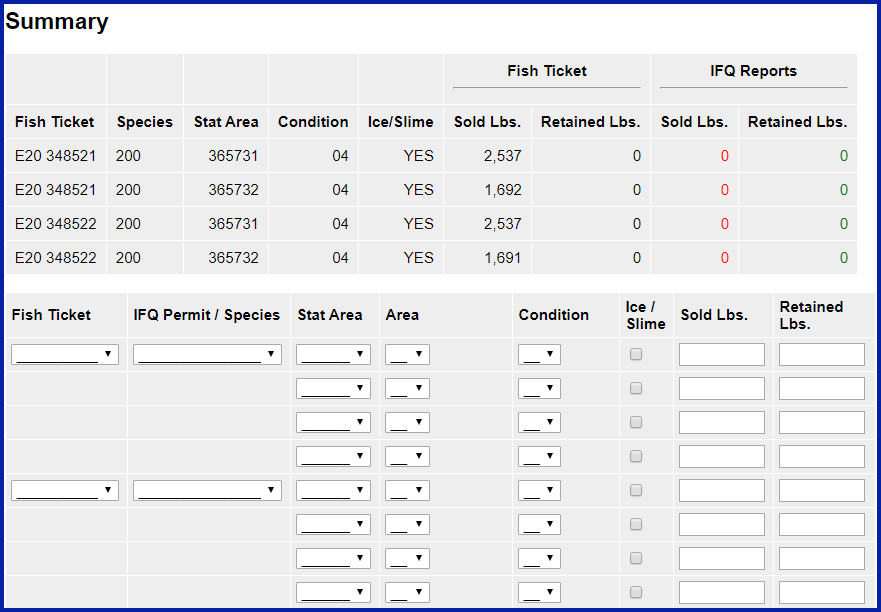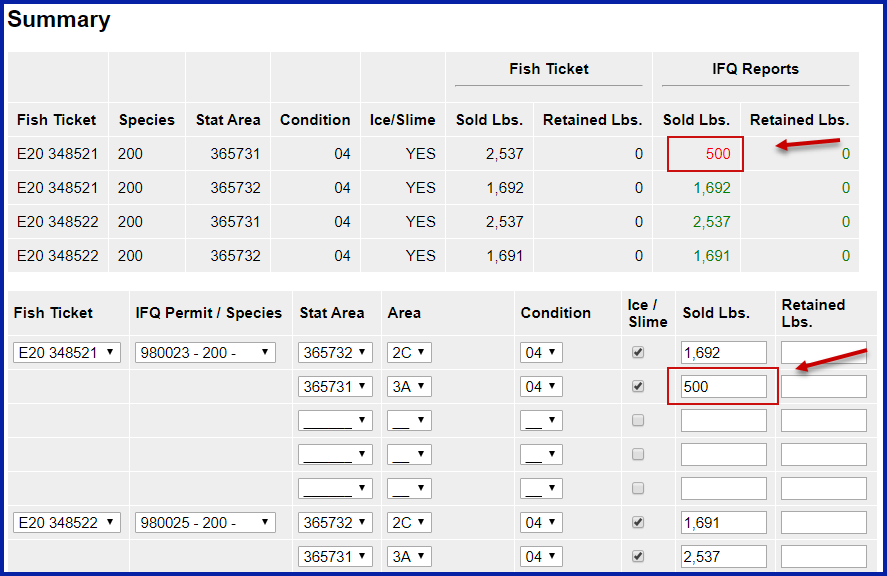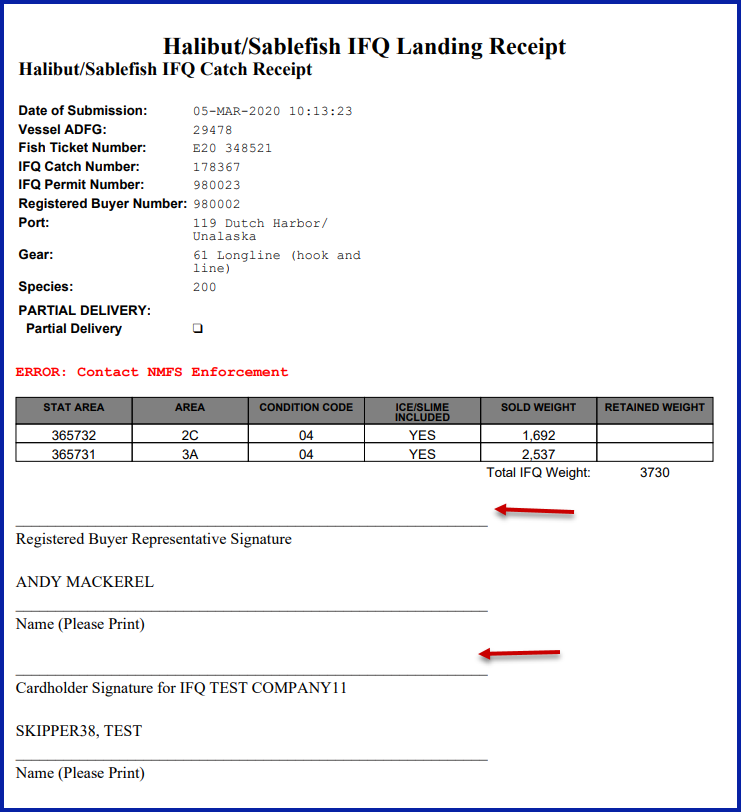The eLandings System provides you with integrated reporting for statewide groundfish and IFQ groundfish, Rationalized Crab IFQ fisheries, and non-IFQ CDQ crab fisheries.
You must be a registered and enabled user to create a landing report in this system. Instructions on how to register in eLandings can be found here: How to Register a New Operation in eLandings
- The eLandings System meets all landing report requirements for the Alaska Department of Fish and Game (ADF&G) and National Marine Fisheries Service (NMFS).
- When a landing report is submitted in the eLandings System, the application returns a printable PDF file of the ADF&G fish ticket(s) and an IFQ receipt(s) for both the fisher and processor's records.
- Fish tickets need to be finalized electronically within seven days of landing. A signed copy of the ADF&G fish ticket(s) must be submitted to the local office of ADF&G, in the same manner as paper fish tickets.
Login to eLandings
To create a groundfish or crab landing report, you will need to login to the eLandings web interface which can be found here: https://elandings.alaska.gov/elandings/Login.
- Enter your User ID and your Password.
Once your User ID and Password have passed validation, the Reports Menu page will appear.
- From this location you can create a new groundfish landing report. You can also make Crab Landing reports if necessary in addition to Salmon Troll Bycatch landings.
- Individual users can be associated with one or more Operations.
- For example, a business manager might be associated with three Operations - Big Fish Inc, WAI Processing, and the stationary floating processor, The Happy Lady. Each of these operations is unique, and the user is an authorized for each operation.
- When the user logs into the eLandings system, he/she must designate the Operation that will be used to record landing information.
- While most users are associated with only one Operation, if your business buys and processes, and/or performs custom processing for another Operation, there will be more than one listed under your User Account.
- Once the Operation has been chosen, you can click on the Groundfish Landing Report button to open the form.
Create new landing report
To create a new landing report, simply click on the selection button for the report you would like to create.
The landing report is divided into several web pages that you will move through in sequential order:
- Vessel, Permit, and Location Information
- Itemized Catch
- IFQ Reports (if applicable)
- Grading & Pricing
Landing Report - Vessel, Permit, and Location Information
- This is the first screen that is displayed when creating a new landing report. Note that some of the required information about your operation is auto-filled based on your processor user account.
- The eLandings System auto-fills your Port of Landing, ADF&G Processor Code, your Registered Crab Receiver(RCR) Number and your Registered Buyer Number.
When you established your User Account and Operation, you entered all of the federal and state permits associated with your operation.
- You should note that a unique Landing Report number is generated each time you initiate a groundfish landing report.
Vessel Information
- ADF&G Vessel Number: this is the five digit number permanently assigned by the Commercial Fishery Entry Commission (CFEC). For motherships, enter the ADF&G number for the catcher vessel that delivers the catch to your mothership.
- ADF&G Gear Code: this is the two digit numeric code used to identify the gear used to harvest the catch. These gear codes are listed in the appendix of this document and can also be viewed by clicking on the Gear Codes link. For motherships, enter the gear type for the catcher vessel that delivers the catch to your mothership.
- Gear Modifier: State and federal biologists have noted a difference in gear selectivity between hard and slinky pots. Therefore, they have requested that vessels catching groundfish with pot gear document whether they are using traditional “hard” pots or flexible “slinky” pots in eLandings. Collecting this information will assist them in increasing their stock assessment accuracy. The new field appears only on the groundfish landing report and is only for use with pot gear. This field is a drop down menu with two choices: Hard pot or Slinky pot. If the vessel is using a combination of pot types, please document the predominate type. For landings on or after September 23, 2021, a warning message will appear if this information is not reported. Beginning January 1, 2022 this information will be required.
- Crew Size: the number of licensed crew on board the vessel, including skipper. For motherships, enter the crew size of the catcher vessel that delivers the catch to your mothership.
- Number of Observers Onboard: the number can range from zero 0 to 5, and references the number of state of Alaska certified crab or NMFS certified groundfish observers on board the vessel for that fishing trip.
- Date Fishing Began: when the gear was deployed in the water to begin fishing.
- Days Fished: when the gear was being fished. This number does not include traveling to and from the fishing grounds, or weather delays.
- Date of Landing: when the landing was completed.
- Port of Landing: location where the landing occurred. This value is auto-filled from your User Agreement registration. You can modify this value to indicate the correct location for this landing.
- ADF&G Processor Code: the owner of the product that has just been purchased - the purchaser. This value is auto-filled from your User Agreement registration. This value is auto-filled from your User Agreement registration. Select the correct number if one than one RCR is associated with your User Agreement.
- ADF&G Processor Code (Custom Processor): applicable only if the product is being received or processed by a third party - not the purchaser.
- Partial Delivery: check if, Yes, the vessel has made deliveries to other operations or processors from this fishing trip, in other words, deliveries elsewhere, or if the delivery to your operation is only a portion of the catch.
- If you created more than one landing report for a delivery, you should also check the PartialDelivery box, to indicate Yes.
- Registered Crab Receiver Number: the appropriate receiver number for this delivery. This value is auto-filled from your User Agreement registration. Select the correct number if one than one RCR is associated with your User Agreement.
- Discard Report: Discard reports are required by federal regulation to be given to the processor at the time of a groundfish offload if the vessel is federally permitted and is greater than or equal to 60 feet in overall length.
- Use the drop-down list to indicate receipt of the discard report.
CFEC & IFQ Permit Worksheets
- A CFEC permit is required for all vessel operators and they must be appropriate for their applicable fishery. They are also required for any individual(s) who will be fishing and selling seafood product as an IFQ shareholder, or on behalf of the actual IFQ permit holder.
- To swipe a permit card, with the CFEC Fishery box active, swipe the permit card. Text will appear in the box that looks like: %BB09B 00155X^SMITTY FISHY ^1801QISLANDER ?;00155180100008139275?
- Once you hit the save button the permit information will populate into the landing report.
CFEC Permit Worksheet
- CFEC Fishery > Permit Number > Permit Sequence
- Management Program > Program ID (CDQ, AFA, RPP)
- Percentage - when there are multiple permit holders, this field can be used to allocate catch percentages among them
- The eLandings application can accommodate an unlimited number of CFEC permits and IFQ permits for each of these requisite CFEC permits.
- We recommend you collect all IFQ permits, Hired Master permits, and CDQ permits (as applicable) prior to beginning the reporting process.
- The CFEC permit must be valid for the calendar year and valid for the fishery (species, gear, management area).
- Anyone fishing and selling product under a CDQ allocation and individuals fishing for golden king crab allocation to the Community of Adak require a separate CFEC permit.
- A NMFS ID is assigned when a person applies for a federal permit with NMFS.
- The NMFS ID must correspond to the individual whose name is on the CFEC permit.
If the individual(s) does not provide a valid permit(s), the Alaska State Troopers, Fish and Wildlife Protection must be notified before off-load begins.
Statistical Area Worksheet
Referred to as the Stat Area Worksheet, this is the area of the Vessel, Permit, and Location Information of the landing report to record the six-digit ADF&G statistical area denoting the actual area of catch.
Groundfish/shellfish statistical area charts may be obtained from your local ADF&G office, or at http://www.cf.adfg.state.ak.us/geninfo/maps.php#shellfish.
- The National Marine Fisheries Service (NMFS) and the International Pacific Halibut Commission (IPHC) reporting area codes may not be used to substitute for the ADF&G statistical area codes.
- This worksheet may be used to document a single statistical area, with 100%, or multiple statistical areas.
- The recording of multiple statistical areas in the worksheet requires that the species that are caught and discarded are equally distributed across all statistical areas fished; and all statistical areas fished are open to the species fished.
- If the criteria are met, enter all of the statistical areas that were fished in the field labeled Stat Area and enter the percentage of the catch taken in the area in the area labeled Percent.
- If all of the species recorded on the ticket were from a single statistical area, enter the Stat Area and 100%.
- If you use the Stat Area Worksheet, there is no need to enter the statistical area code and percent anywhere else on the landing report.
- All ADF&G statistical areas that are documented within the Statistical Area Worksheet are translated to the NMFS Reporting Area and the IPHC Reporting Area, as it pertains to the fishery.
- If one or more species are not harvested in a manner that is equally distributed across all statistical areas fished, the catch must be recorded in the Add/Edit Itemized Catch section of the eLandings landing report.
Upon the completion of the 'header' (Vessel, Permit, and Location Information section) of the landing report, select SAVE.
The data that you submit to the repository database is validated for accuracy. The program will return a message indicating whether the save was successful or if corrective action must take place.
Incomplete Reports
The eLandings System allows you to enter the 'header' information, also known as the Vessel, Permit, and Location Information section of the landing report.
- The 'header' information can be saved as an unsubmitted report.
- After the vessel off-load is complete and the tally sheet completed, the itemized catch and price information can be recorded and saved.
- This activity creates an Initial Report that must be submitted.
Stacked Permits
Stacked permits are allowable in groundfish and crab fisheries. The eLandings System allows you to record all CFEC and IFQ permits on one landing report and select unique fish ticket assignment of catch.
When you save the 'header' information of the landing report - the Vessel, Permit and Location Information section, a fish ticket number is automatically assigned. If more than one CFEC permit is recorded in the eLandings System, a unique fish ticket number is assigned for each CFEC permit. IFQ harvest can be automatically assigned to the itemized catch - line item(s),and it can also be selected from the Fish Ticket drop-down menu. This drop-down field lists any and all fish ticket numbers associated with this specific landing report.
When you have completed recording the itemized catch select SAVE. The application will message back if the itemized catch was successfully saved.
General Guidelines for Reporting Pounds on Groundfish Fish Tickets
The eLandings System is designed to record the landed or scale weight of the catch.
- In other words, the processor should record the weight of the catch and the delivery condition of the fish at the point of offload where the catch is weighed on an approved scale.
- Do not calculate the itemized catch to round pounds.
- Record the poundage of the catch and the corresponding delivery condition at the point that it is weighed.
- The eLandings System allows you to select a 2% ice and slime deduction for IFQ halibut and sablefish. The system does the math for you and you can see the weight differences on the Groundfish Grading and Pricing screen.
Add/Edit Itemized Catch: recording sold, retained, and discarded catch
- Once you have successfully saved the 'header' information of the landing report - the Vessel, Permit, and Location Information, you can move on to add itemized catch.
- Please note: All landing reports of IFQ species must be finalized within two hours after completion of offload.
- Processors should reference NMFS 679.5 record keeping and reporting regulations.
- As a general rule, landing reports should be completed and finalized within seven days of the landing.
- Incomplete Landing Reports can be accessed from the Reports Menu Page.
Itemized catch encompasses a combination of species codes, delivery condition (at the point it is weighed), and disposition (what is being done with the product).
- As covered in the Statistical Area Worksheet discussion, it can also include harvest from a unique statistical area.
Combination examples include the following:
Species | Delivery Condition | Disposition |
|---|---|---|
Halibut | Gutted, Head Off | Sold for Human Consumption |
Halibut | Gutted, Head Off | Personal Use |
Pacific Cod | Bled Only | Sold for Human Consumption |
Pacific Cod | Whole Fish | Sold for Human Consumption |
Pacific Cod | Whole Fish | Discard at Sea |
Pacific Cod | Whole Fish | Discard at the Dock |
- In each of these situations, a separate line item must be recorded in the application. Poundage for each unique category must be recorded.
Enter the codes for the following:
- Species
- Condition (Delivery Condition)
- Pounds
- Number - required for crab and prohibited species discarded at sea with no scales to weigh product.
- Pot Lifts - crab only.
- Disposition - the intended use or disposal of the product.
- Statistical Area (if the Stat Area Worksheet is not used, or if this portion of the catch was harvested in a unique or non-proportional area(s).
Stat Area, Species, Condition, and Disposition codes are linked and easily referenced.
Weight Modifier
- The eLandings Groundfish Report allows users to record landings of IFQ species "with ice and slime".
- When the weight modifier "With Ice/Slime" is selected, a two (2%) percent reduction in the recorded scale weight is automatically configured by the system.
- In limited situations, a processor may take possession of Pollock or flatfish, but be unable to immediately weigh the product, or sort by species and weigh the product, while the vessel operator is still present.
- The processor can select "estimated" for Pollock - code 270 or general flatfish -code 120, only.
- The report can be submitted as an initial report, allowing the fish ticket to be created, printed and signatures obtained.
- The final weights, and specific species must be recorded for this landing report, within 72 hours of the submission of the initial report.
- Again, the use of estimated weight is available for groundfish species Pollock and general flatfish species only.
- When all itemized catch by category are documented, select save.
Allocate Permits
- Once you have completed the itemized catch section of the report, you are ready to allocate the harvest to the permit or permits.
- If the landing report consists of one or several CFEC permits, you will need to allocate the harvest to the fish tickets.
- If you assign fish ticket numbers to each itemized catch line, you are manually allocating the permits to pounds.
- If you do not select the fish ticket numbers when adding itemized catch information, you can Allocate with the click of one button in the next step.
- The Allocate Permits button is located just below the listed CFEC Permit(s).
- In this example, the program messages back that two fish tickets were created.
- Review the allocated catch, by fish ticket number.
- If the allocation is not acceptable, or incorrect, select the Undo Allocation button.
- This will allow you to redistribute the harvest until acceptable to all stakeholders.
- The eLandings System provides a listing of all items by fish ticket number and a summary by species, by fish ticket number.
- These should be reviewed prior to the submission of the landing report.
- Upon review, if the landing report is accurate and acceptable to all stakeholders, select Submit Initial Report.
Add/Edit Grading and Pricing
- If you have determined the price of the itemized catch at the conclusion of the off-load, and have completed grading/sizing, you can complete this portion of the report.
- If you do not have this information completed, or it will occur at a later point in time, proceed with the initial submission of the landing report.
- In the illustration below, size and price information are added to the itemized catch.
- Additional grade/size and price categories are available by selecting, More Lines.
- When saved, the amount is calculated for each price category.
- A total value by price category is displayed. The landing report also displays a Summary with total value by species, below the itemized catch section of the landing report.
Generate, Edit & Submit IFQ Report
Once the Initial Report has been submitted you can generate, edit, and submit the IFQ reports. There are three ways of creating the IFQ reports, explained in detail in sections below.
- you can manually create them; or
- you can let the eLandings program allocate the catch to the IFQ permits.
- you can use the IFQ report builder (crab landing reports only)
The IFQ reports can be reviewed and edited before you submit them. Once the reports are submitted, the IFQ account will be debited and you cannot edit them. Any further changes have to be made through the NMFS Data Clerks.
Manually Create the IFQ Report
If you use this method, you will enter all of the IFQ information yourself and the eLandings program will not do any calculations (if you want to use the automatic calculations, see the 'Generating IFQ Report' section). Once the initial report has been submitted, go to the bottom of the Report Display and click on the Edit IFQ Reports button.
This screen allows you to fill in all the data without any automated calculations (again, if you want to use the automatic calculations, see the 'Generating IFQ Report' section). The edit page works like the itemized catch page. It will prevent you from saving data inconsistent with data entered elsewhere on the Landing Report (Fish Ticket, Permit Worksheet, etc.) and illogical data (like alphabetic characters in numeric fields).
You are allowed to save partially complete data, although unbalanced data cannot be successfully submitted.
This is the blank IFQ page where you can enter the IFQ information manually.
Generate IFQ Report
You can only generate the IFQ Report after you have entered all the itemized catch data and submitted the Initial Report.
Note that the pricing and grading does not have to be finalized to submit the Initial Report and Generate the IFQ.
- Even after you have submitted the Initial Report, you may go back and finalize the pricing and grading information for the fish ticket.
- To generate the IFQ Report, go to the bottom of the Report Display page.
- In the IFQ Summary section, you can click on the Generate IFQ Reports button.
- Generating the reports does not submit them!
- You will still have an opportunity to review and edit the reports before you submit them.
- A message will tell you how many IFQ Reports were generated.
- Now you can scroll down to the IFQ Summary section and review the IFQ reports.
NOTE: If you are creating a crab landing report, another method of generating IFQ reports is available and is discussed in the section called Generating IFQ using IFQ Report Builder. The IFQ Report Builder is an alternate method that distributes catch by disposition among different permits.
Editing the IFQ Report
Once the IFQ Reports have been generated, you can use the Edit IFQ page to make minor changes reports.
Note, you can only edit the IFQ Report until it is submitted. Once the IFQ report has been submitted, the IFQ account will be debited and you cannot edit it. Any further changes have to be made through the NMFS Data Clerks. The Data Clerks are available from 6 a.m. to midnight at: 1-800-304-4846, option #1.
Scroll down to the bottom of the Report Display page and click on the Edit IFQ Reports button.
The edit IFQ page allows you to make changes to all the fields in each of the IFQ Reports. Keep in mind that the program will prevent you from saving data inconsistent with data entered elsewhere on the Landing Report (Fish Ticket, Permit Worksheet, etc.). So if there are small errors in the number of pounds on an IFQ Report due to rounding, for example, then you may make these edits.
If you make changes, click on the Save and Continue button. This will save your changes and bring you back to the Edit IFQ page so you can review your edits. As long as the pounds in the Summary section are green in color then your IFQ Report and fish ticket are "in balance" if the pounds are in RED then you are out of balance and the eLandings program will not allow you to submit the IFQ report.
If you need to make major edits to the IFQ report and the pounds keep getting out of balance, you need to go back to the itemized catch section of the landing report to make changes. If so, first remove the unsubmitted IFQ Reports before you make edits to the itemized catch. Then, once you have made your edits, you will be able to generate the IFQ Reports a second time.
Removing an Unsubmitted IFQ Report
There are several scenarios when you might need to remove an unsubmitted IFQ Report:
- If you generated the IFQ report, but then ended up doing a manual landing via the Data Clerks. In this case, you cannot Finalize your landing report until you delete the unsubmitted IFQ repots.
- You need to edit the itemized catch or stat area worksheet on your landing report. In this case you need to remove the unsubmitted IFQ report, make your edits, and then re-generate the IFQ report for the second time.
- To remove the report, first go to the Edit IFQ Reports page:
- Then click on the Remove Unsubmitted Reports button:
Submitting the IFQ Report & Printing Receipts
- Once you have created and reviewed the IFQ Reports and everything looks good, then you can submit them.
- Click on the Submit IFQ Reports button.
- Once you successfully submit your IFQ Report, an eLandings message will inform you that they were submitted.
- Scroll down to the IFQ section of the Report Display page and in the IFQ Reports section check that status of your reports now says "Submitted."
- Notice that you also have a transaction number which means that the IFQ account was debited in the database.
The Next step is to View and Print the IFQ Receipts. Simply click on the View Receipts to Print button and a pdf file will open in a new browser window.
- Print all of the receipts.
- The Registered Buyer and the IFQ Holder need to sign each of the receipts.
"Red Line" Errors on an IFQ Report
If you submit your IFQ Reports and in the status column there is a message in red text that says "Contact NMFS Enf" this is referred to as a 'red line' error.
There are many reasons that you could have received this error, but whatever the reason, you must contact NMFS Enforcement.
The NMFS Enforcement Data Clerks can assist you from 6 a.m. to midnight at (800)304-4646, option #1, during their business hours.
If no one is available to assist you at other times, you will need to wait until 6 am.
